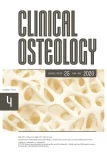Bone and immune system – osteoimmunology
Authors:
Šterzl Ivan 1,2; Pikner Richard 1,3,4
Authors‘ workplace:
Oddělení klinických laboratoří, pracoviště kostního metabolizmu, Klatovská nemocnice a. s., Klatovy
1; Oddělení klinické imunoendokrinologie, Endokrinologický ústav, Praha
2; Ústav klinické biochemie a hematologie LF UK a FN Plzeň
3; Katedra záchranářství, diagnostických oborů a veřejného zdravotnictví, Fakulta zdravotnických studií Západočeské, univerzity v Plzni
4
Published in:
Clinical Osteology 2020; 25(4): 201-205
Category:
Overview
Bone is a multifunctional organ that responds to various exogenous and endogenous stimuli, such as calcium intake, mechanical stress, aging, tumors, infectious and autoimmune diseases. The basic functions of bone are mechanical, hematopoetic and the regulation of calcium-phosphate metabolism, and both endocrine and immune systems are interacting with them. In the 1990s, the field of osteoimmunology was established, that because of joint interest in estrogens, vitamin D, parathyroid hormone and interactions with the immune system, significantly cooperates with immunoendocrinology. Mechanisms of both adaptive (cells and antibodies) and innate immunity (cytokines) act on bone metabolism. Under the physiological state, the adaptive immune system favorably regulates the development and quality of the skeleton. However, in immunopathological situations, such as autoimmune diseases, immunodeficiency or inflammatory response to infectious diseases, bone metabolism is significantly affected and that may lead to severe bone damage (generalized or local osteoporosis).
Keywords:
cytokines – hormones – immunity – osteoblast – osteoclast – RANK – RANKL – vitamin D
Sources
- Arron JR, Choi Y. Bone versus immune system. Nature 2000; 408(6812): 535–536. Dostupné z DOI: <http://dx.doi.org/10.1038/35046196>.
- Takayanagi H. Osteoimmunology and the effects of the immune system on bone. Nat Rev Rheumatol 2009; 5(12): 667–676. Dostupné z DOI: <http://dx.doi.org/10.1038/nrrheum.2009.217>.
- Takayanagi H, Kim S, Koga T et al. Induction and activation of the transcription factor NFATc1 (NFAT2) integrate RANKL signaling in terminal differentiation of osteoclasts. Dev Cell 2002; 3(6): 889–901. Dostupné z DOI: <http://dx.doi.org/10.1016/s1534–5807(02)00369–6>.
- Long F. Building strong bones: molecular regulation of the osteoblast lineage. Nat Rev Mol Cell Biol 2011; 13(1): 27–38. Dostupné z DOI: <http://dx.doi.org/10.1038/nrm3254>.
- Kalajzic I, Matthews BG, Torreggiani E et al. In vitro and in vivo approaches to study osteocyte biology. Bone 2013; 54(2): 296–306. Dostupné z DOI: <http://dx.doi.org/10.1016/j.bone.2012.09.040>.
- Okamoto K, Nakashima T, Shinohara M et al. Osteoimmunology: The Conceptual Framework Unifying the Immune and Skeletal Systems. Physiol Rev 2017; 97(4): 1295–1349. Dostupné z DOI: <http://dx.doi.org/10.1152/physrev.00036.2016>.
- Ponzetti M, Rucci N. Updates on Osteoimmunology: What’s New on the Cross-Talk Between Bone and Immune System. Front Endocrinol (Lausanne) 2019; 10: 236. Dostupné z DOI: <http://dx.doi.org/10.3389/fendo.2019.00236>.
- Fuller K, Murphy C, Kirstein B et al. TNFalpha potently activates osteoclasts, through a direct action independent of and strongly synergistic with RANKL. Endocrinology 2002; 143(3): 1108–1118. Dostupné z DOI: <http://dx.doi.org/10.1210/endo.143.3.8701A.
- Durup D, Jørgensen HL, Christensen J et al. A Reverse J-Shaped Association of All-Cause Mortality with Serum 25-Hydroxyvitamin D in General Practice: The CopD Study. J Clin Endocrinol Metab 2012; 97(8): 2644–2652. Dostupné z DOI: <http://dx.doi.org/10.1210/jc.2012–1176>.
- Andjelkovic Z, Vojinovic J, Pejnovic N et al. Disease modifying and immunomodulatory effects of high dose 1 alpha (OH) D3 in rheumatoid arthritis patients. Clin Exp Rheumatol 1999; 17(4): 453–456.
- Bodine PV, Komm BS. Wnt signaling and osteoblastogenesis. Rev Endocr Metab Disord 2006; 7(1–2): 33–39. Dostupné z DOI: <http://dx.doi.org/10.1007/s11154–006–9002–4>.
- Sayegh MH. Finally, CTLA4Ig graduates to the clinic. J Clin Invest 1999; 103(9): 1223–1225. Dostupné z DOI: <http://dx.doi.org/10.1172/JCI6952>.
- Nitta T, Ohigashi I, Nakagawa Y et al. Cytokine crosstalk for thymic medulla formation. Curr Opin Immunol 2011; 23(2): 190–197. Dostupné z DOI: <http://dx.doi.org/10.1016/j.coi.2010.12.002>.
- Takaba H, Morishita Y, Tomofuji Y et al. Fezf2 Orchestrates a thymic program of self-antigen expression for immune tolerance. Cell 2015; 163(4): 975–987. Dostupné z DOI: <http://dx.doi.org/10.1016/j.cell.2015.10.013>.
- Mathieu C, Van Etten E, Overbergh L et al. Vitamin D3 in Control of Immune Response. In: Geenen V, Chrousos G. Immunoendocrinology in Health and Disease. CRC Press 2004. ISBN-10: 0824750608. ISBN-13: 978–1840761436.
- Blaney GP, Albert PJ, Proal AD. Vitamin D metabolites as clinical markers in autoimmune and chronic disease. Ann N Y Acad Sci 2009; 1173: 384–390. Dostupné z DOI: <http://dx.doi.org/10.1111/j.1749–6632.2009.04875.x>.
- Wong BR, Josien R, Lee SY et al. TRANCE (tumor necrosis factor [TNF]-related activation-induced cytokine), a new TNF family member predominantly expressed in T cells, is a dendritic cell-specific survival factor. J Exp Med 1997; 186(12): 2075–2080. Dostupné z DOI: <http://dx.doi.org/10.1084/jem.186.12.2075>.
- Yasuda H, Shima N, Nakagawa N et al. Osteoclast differentiation factor is a ligand for osteoprotegerin/osteoclastogenesis-inhibitory factor and is identical to TRANCE/RANKL. Proc Natl Acad Sci USA 1998; 95(7): 3597–3602. Dostupné z DOI: <http://dx.doi.org/10.1073/pnas.95.7.3597>.
- Takayanagi H. Osteoimmunology: shared mechanisms and crosstalk between the immune and bone systems. Nat Rev Immunol 2007; 7(4): 292–304. Dostupné z DOI: <http://dx.doi.org/10.1038/nri2062>.
- Sato K, Suematsu A, Okamoto K et al. Th17 functions as an osteoclastogenic helper T cell subset that links T cell activation and bone destruction. J Exp Med 2006; 203(12): 2673–2682. Dostupné z DOI: <http://dx.doi.org/10.1084/jem.20061775>.
- Anderson G, Takahama Y. Thymic epithelial cells: working class heroes for T cell development and repertoire selection. Trends Immunol 2012; 33(6): 256–263. Dostupné z DOI: <http://dx.doi.org/10.1016/j.it.2012.03.005>.
- Hikosaka Y, Nitta T, Ohigashi I et al. The cytokine RANKL produced by positively selected thymocytes fosters medullary thymic epithelial cells that express autoimmune regulator. Immunity 2008; 29(3): 438–450. Dostupné z DOI: <http://dx.doi.org/10.1016/j.immuni.2008.06.018>.
- Komatsu N, Okamoto K, Sawa S et al. Pathogenic conversion of Foxp3+ T cells into Th17 cells in autoimmune arthritis. Nat Med 2014; 20(1): 62–68. Dostupné z DOI: <http://dx.doi.org/10.1038/nm.3432>.
- Bailey-Bucktrout SL, Martinez-Llordella M, Zhou X et al. Self-antigen-driven activation induces instability of regulatory T cells during an inflammatory autoimmune response. Immunity 2013; 39(5): 949–962. Dostupné z DOI: <http://dx.doi.org/10.1016/j.immuni.2013.10.016>.
Labels
Clinical biochemistry Paediatric gynaecology Paediatric radiology Paediatric rheumatology Endocrinology Gynaecology and obstetrics Internal medicine Orthopaedics General practitioner for adults Radiodiagnostics Rehabilitation Rheumatology Traumatology OsteologyArticle was published in
Clinical Osteology

2020 Issue 4
Most read in this issue
- Diagnosis and treatment of Paget´s disease of bone: update 2020
- Nutritional (vitamin D deficient) rickets – a neglected diagnosis? Case report
- FRAX bring greater benefit
- Bone and immune system – osteoimmunology
